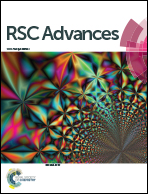Photoluminescent sea urchin-shaped carbon-nanobranched polymers as nanoprobes for the selective and sensitive assay of hypochlorite†
Abstract
This work reports donor–acceptor type sea urchin-like carbon nanobranched polymers (SUCNPs). As a novel carbon-based nanomaterial, SUCNPs were effectively synthesized for the first time through a facile and economical solvothermal approach employing uric acid and L-cysteine as nitrogen/sulfur sources. The nitrogen-rich structure of the heterocylic aromatic polymer led to a blue fluorescence at the excitation/emission maxima of 350/436 nm with robust photostability. SUNCPs showed highly selective ability towards hypochlorite (ClO−) against other relevant interfering substances. Upon exposure to a growing concentration of ClO−, SUCNPs fluorescence presented a gradual rise with a remarkable blue shift by virtue of the inhibition of photoinduced charge transfer (PCT) process. A linear relationship was established between the fluorescence intensity ratio (I401 nm/I436 nm) and the ClO− concentration in the range of 0.1–200 μM. The detection limit was as low as 30 nM (3σ/k). The “turn-on” type nanoprobe was further used in real samples and paper-based analytical chips efficiently, implying its application in a sophisticated and convenient platform.



 Please wait while we load your content...
Please wait while we load your content...